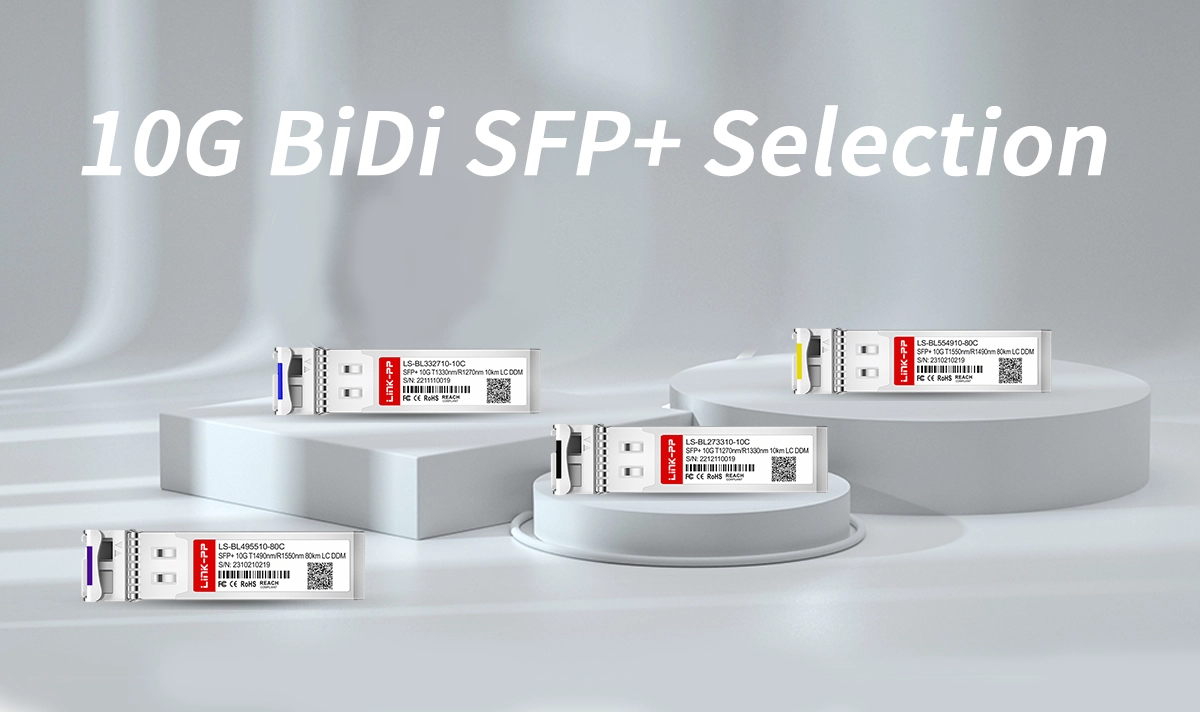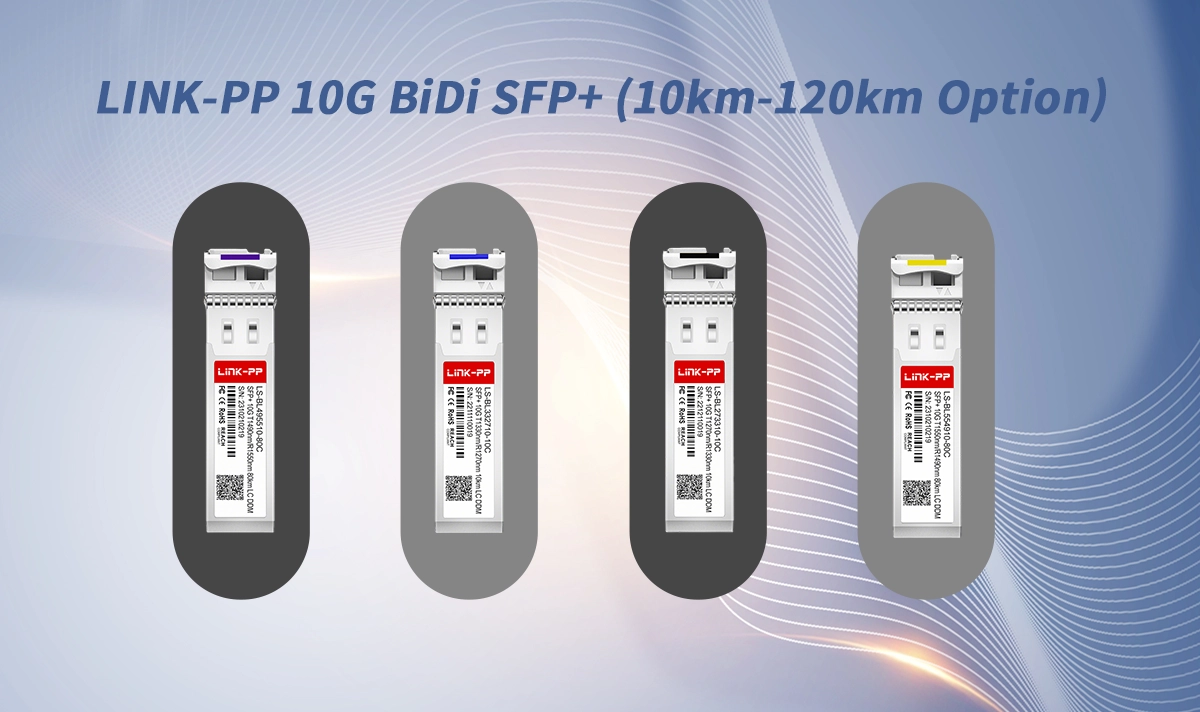
Struggling with limited fiber strands but need reliable 10G connectivity? Bidirectional (Bidi) optical modules are the ingenious solution, allowing data transmission and reception over a single fiber strand. This guide cuts through the complexity, providing network engineers and procurement specialists with the essential knowledge for selecting the right 10G Bidi SFP+ modules, maximizing your existing fiber infrastructure while ensuring performance and compatibility. Discover how LINK-PP's high-quality optics deliver cost-effective efficiency.
🔍 Why 10G Bidi Optics? The Fiber Savior
Traditional duplex optics require two fibers (one TX, one RX). 10G Bidi transceivers utilize wavelength-division multiplexing (WDM) technology to send and receive signals on different wavelengths over a single fiber. This effectively doubles your existing fiber capacity – a game-changer for:
Cost Reduction: Slash expenses on new fiber cabling installations.
Maximizing Legacy Fiber: Extend the life and utility of your current fiber plant.
High-Density Deployments: Perfect for space-constrained data centers and access networks.
Network Upgrades: Seamlessly transition to 10G speeds without overhauling physical infrastructure.
📊 Key Factors for 10G Bidi SFP+ Module Selection
Choosing the right module isn't just about grabbing the cheapest option. Consider these critical parameters:
Wavelength Pairing (Crucial!): Bidi modules work in matched pairs. Common 10G pairs include:
1270nm TX / 1330nm RX
1330nm TX / 1270nm RX
1550nm TX / 1490nm RX
1490nm TX / 1550nm RX
📌 Pro Tip: You MUST use complementary wavelengths at each end of the fiber link. Mismatched pairs will NOT work.
Transmission Distance: Match the module's reach to your link length.
SR (Short Reach): Typically up to 300 meters over Multimode Fiber (MMF - OM3/OM4). Less common for Bidi, which is primarily for Single-Mode Fiber (SMF) efficiency.
LR (Long Reach): Standard for Bidi over SMF. Common distances: 10km, 20km, 40km, 80km. Select based on actual path length plus margin for splices/connectors.
Fiber Type:
Single-Mode Fiber (SMF): The primary fiber type used with 10G Bidi LR modules for distances beyond a few hundred meters. Ensure your fiber plant is SMF.
Multimode Fiber (MMF): While possible, 10G Bidi over MMF (SR-Bidi) is far less common than SMF deployments. Verify module compatibility (OM3/OM4).
DOM (Digital Optical Monitoring) Support: Essential for proactive network management. DOM provides real-time monitoring of:
Transceiver Temperature
Laser Bias Current
Transmitted Optical Power (Tx Power)
Received Optical Power (Rx Power)
Enables troubleshooting and predictive maintenance.
Compliance & Interoperability: Ensure modules comply with relevant standards:
IEEE 802.3ae 10GBASE-BX Standards: Defines the 10G Bidi physical layer specifications.
SFF-8472 Rev 12.0+: Standard for DOM implementation.
MSA (Multi-Source Agreement) Compliant: Ensures physical and electrical compatibility with SFP+ ports from major switch/router vendors (Cisco, Juniper, Arista, HPE, Dell, etc.).
Quality & Reliability: Opt for manufacturers with rigorous testing (full temperature range, BER testing) and strong warranties. LINK-PP SFP modules undergo extensive validation for reliability and performance consistency.
Operating Temperature: Choose Commercial (0°C to 70°C), Extended (-5°C to 85°C), or Industrial (-40°C to 85°C) grade based on your deployment environment (data center vs. outdoor cabinet).
📋 10G Bidi SFP+ Module Comparison & LINK-PP Solutions
Feature | Specification | |||
|---|---|---|---|---|
Wavelength | 1270nm/1330nm or 1490nm/1550nm | 1270nm TX / 1330nm RX | 1330nm TX / 1270nm RX | 1490nm TX / 1550nm RX |
Reach | 10km, 20km, 40km, 80km | 10km over SMF | 40km over SMF | 80km over SMF |
Fiber Type | Single-Mode Fiber (SMF) | G.652 SMF | G.652 SMF | G.652 SMF |
DOM Support | Yes | Yes | Yes | Yes |
Temp Range | Comm: 0°C to 70°C, Ext: -5°C to 85°C, Ind: -40°C to 85°C | Commercial (0°C to 70°C) | Commercial (0°C to 70°C) | Industrial (-40°C to 85°C) |
Compliance | IEEE 802.3ae, SFF-8472, MSA | Yes | Yes | Yes |
Key Use Case | Cost-effective 10G links, Metro Access | Standard 10km links, Campus | Longer campus links, Metro Edge | Long Haul Metro, ISP Backhaul |
Best For | Maximizing fiber in data centers, enterprise | Enterprise Core/Distribution | Service Provider Access, FTTx | Challenging environments, Long reach |
🛠️ Installation & Deployment Best Practices
Pair Matching is Paramount: Double and triple-check that the modules at each end use the exact complementary wavelengths (e.g., 1490nm/1550nm at End A, 1550nm/1490nm at End B). Label cables clearly!
Clean Fiber Connectors: Contamination (dust, oil) is the #1 cause of optical link failures. Always inspect and clean every fiber connector (LC) before insertion using certified tools.
Verify Link Budget: Calculate your total link loss (fiber attenuation, connectors, splices) and ensure it is below the receiver sensitivity (minus a safety margin) of the chosen Bidi module. Overdriving or underdriving the receiver causes errors.
Check Power Levels: Use an optical power meter to verify Tx power (within spec) and Rx power (above receiver sensitivity but below overload level) after installation. DOM values provide ongoing monitoring.
Bend Radius: Avoid sharp bends in the fiber cable, especially near connectors. Respect the minimum bend radius specified for the cable type (SMF is particularly sensitive).
Vendor Compatibility Testing: While MSA-compliant modules should work, always verify compatibility with your specific switch/router model if possible. LINK-PP provides extensive compatibility lists.
✅ Why Choose LINK-PP 10G Bidi SFP+ Modules?

Uncompromising Quality: Rigorous production controls and 100% testing ensure industry-leading performance and longevity, minimizing network downtime.
Broad Compatibility: MSA-compliant design validated across major platforms (Cisco, Juniper, Arista, Brocade, HPE, Dell, Fortinet, Ubiquiti, MikroTik etc.). Check our detailed compatibility lists online.
Full DOM Support: Real-time diagnostics for proactive network health monitoring and troubleshooting.
Cost Efficiency: Deliver significant fiber cost savings without sacrificing performance or reliability, offering an excellent ROI.
Comprehensive Range: Solutions covering all standard 10G Bidi distances (10km, 20km, 40km, 80km) and temperature grades.
Industry-Leading Warranty & Support: Backed by strong warranties and responsive technical support.
Ready to Double Your Fiber Capacity?
Stop letting limited fiber strands bottleneck your network upgrades. 10G Bidi SFP+ modules from LINK-PP provide the proven, reliable, and cost-effective solution you need to achieve high-speed 10G connectivity while maximizing your infrastructure investment.
👉 Explore the full range of high-performance, compatible 10G Bidi SFP+ modules today! Find the perfect LINK-PP model for your distance, wavelength, and environmental needs. [Visit Our 10G Bidi Solutions Page]
💡 Real-World Applications: Where 10G Bidi Shines
Fiber-to-the-Home/Business (FTTx): Efficiently connect OLTs to ONTs over existing single fiber drops. LINK-PP modules are widely deployed in GPON and XGS-PON backhaul.
Metro & Access Networks: ISPs leverage Bidi for cost-effective 10G links in metro rings and access aggregation. Maximize your fiber plant investment.
Enterprise Campus Networks: Connect buildings or distribution layers within a campus over limited fiber pairs. Ideal for campus backbone upgrades.
Data Center Interconnect (DCI): For shorter DCI links where fiber is constrained.
Wireless Backhaul: Providing 10G connectivity for 4G/LTE and emerging 5G cell sites.
🔚 Conclusion
Selecting the optimal 10G Bidi SFP+ module is a strategic decision impacting network performance, cost, and scalability. By understanding the critical factors – wavelength pairing, distance, fiber type, DOM, compliance, and quality – you can confidently deploy solutions that unlock the full potential of your existing fiber infrastructure. LINK-PP stands as a trusted partner, delivering high-performance, reliable, and compatible 10G single fiber transceivers backed by rigorous testing and expert support. Embrace the efficiency of bidirectional optics and propel your network forward.
📌 Frequently Asked Questions (FAQs)
Q: Can I mix brands for Bidi pairs?
A: Technically, if both are MSA-compliant and use the exact same wavelengths, it can work. However, for guaranteed performance, interoperability, and support, using matched pairs from the same reputable manufacturer like LINK-PP is strongly recommended.Q: What's the difference between Bidi and standard duplex SFP+?
A: Standard duplex uses two fibers (one TX, one RX). Bidi uses WDM to send TX and RX signals on different wavelengths over a single fiber strand, effectively halving the fiber required per link. Both provide 10G speed.Q: How do I know which wavelength pair I need?
A: It's arbitrary as long as the ends are complementary. Convention often uses 1270nm/1330nm for one direction and 1330nm/1270nm for the other. Consistency across your network for similar link types is helpful for management. LINK-PP clearly labels modules (e.g., LS-BL273310-10C & LS-BL332710-10C).Q: Can 10G Bidi modules work over multimode fiber (MMF)?
A: While possible (10G BiDi SR), it's significantly less common than SMF deployments. The vast majority of single fiber SFP+ deployments leverage SMF for its longer reach and Bidi's fiber-saving advantage. Verify module specs carefully if considering MMF.Q: What is the maximum transmission distance for 10G Bidi?
A: Standard 10G Bidi transmission distances are 10km, 20km, and 40km over standard Single-Mode Fiber (G.652) and the maximum transmission can be reach to 120km. Always choose a module rated for at least your actual link length plus margin. LINK-PP offers all standard reaches.




